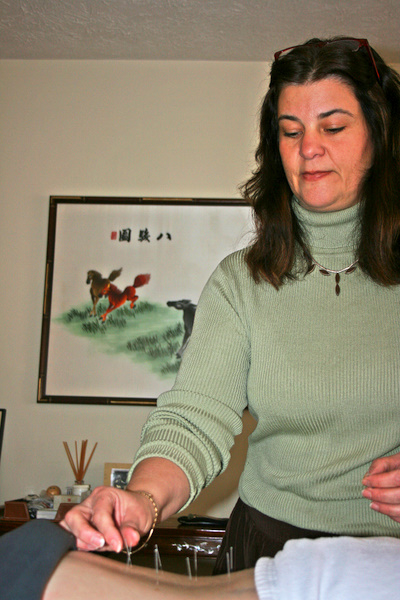Acupuncture has been used in China for at least 2,000 years to treat a variety of disorders. The use of acupuncture for the treatment of drug addiction was discovered serendipitously in 1972 by Wen, a Hong Kong neurosurgeon conducting a series of studies on the analgesic properties of acupuncture. Heroin addicts who volunteered to be subjects reported that their opiate withdrawal symptoms were lessened on the days when they received their acupuncture treatments. Wen undertook a series of uncontrolled studies on the use of acupuncture in the treatment of opiate addiction and reported positive results. Over the last 40 years, numerous studies have been undertaken investigating acupuncture for the treatment of various addictions, including opiates, tobacco, and alcohol. Many of these studies report beneficial effects of acupuncture. Not infrequently however, investigations of acupuncture for the treatment of drug addiction suffer from problems of design and assessment.
 Mechanism of Acupuncture
Mechanism of Acupuncture
The mechanism by which acupuncture may constitute a treatment for chemical dependency has not been fully investigated, although it has been conjectured that acupuncture, perhaps mediated by the release of endogenous opioids, modulates neural circuits in the mid-brain also affected by drugs of abuse. Han JS, Zhang RL (1993) Drug and alcohol Dependence(USA) 31, 169-175 Traditional Chinese theories of acupuncture involving ‘the rectification of chi deficiency or excess in various organ systems’, have not been adequately tested with in Western biomedical frameworks. In 1993 the HANS Acupoint Nerve Stimulator was used to treat 212 heroin addicts subjected to abrupt abstinence. Diagnosis was made according to the Diagnostic and Statistical Manual of Mental Diseases, third edition. The results from that study indicated that the mechanisms of HANS for heroin detoxification may be two fold:
- The release of endogenous endorphins and enkephalins by 2Hz may substitute the need for exogenous opioids
- The release of dynorphins by 100Hz may suppress the withdrawl syndrome.
The use of HANS in the post-detoxification period may help to prevent the recurrence of drug abuse, which may be even more important than its role in acute detoxification.
U.S. Studies
Auricular acupuncture is an increasingly popular intervention for the treatment of cocaine addiction in the United states.
Currently, approximately 200 clinics, in 32 states, offer auricular acupuncture for the treatment of this disorder (Smith 1991). Despite its increasing popularity, auricular acupuncture has been evaluated in relatively few studies for the treatment of cocaine addiction Lipton et al., 1992; Margolin et al., 1992; Smith,1988.
Clinical reports suggest that auricular acupuncture induces a feeling of relaxation that reduces craving for cocaine and facilitates patient participation in counseling and rehabilitation.
To the best of our knowledge, the literature contains only two controlled studies of acupuncture for the treatment of cocaine addiction. One study conducted at Lincoln Hospital, D. Lipton,V. Brewington, and M. Smith, unpublished data and the second one from the Substance Abuse and Treatment Unit, Department of Psychiatry, Yale University school of Medicine.
Cocaine use was determined by urine toxicology screenings. Depression was assessed by using the Beck depression inventory. Self-representation was assessed using the modified selves Questionnaire etc.
The authors report a positive finding for acupuncture insofar as subjects who received real acupuncture and remained in treatment for over 2 weeks had significantly lower levels of benzoylecgonine in urine screens compared to the placebo group. Sixty-one percent of women and 36% of men who entered the study completed the entire 8-week course of acupuncture treatment. All of the women and 60% of the men who completed the study attained abstinence. Among the HIV-positive patients 38% completed the study, of these individuals 83% attained abstinence.
In the pharmacotherapy trial, retention in treatment was excellent, and abstinence rates were modest. In the acupuncture study, the retention rate was lower, but the patients who remained in treatment did extremely well. No subject reported dropping out of the studies because of an adverse response to acupuncture treatments.
Subjects who attained abstinence in these studies exhibited decreased Beck Depression Inventory scores, a shift in self-representation away from “addict” and toward desired “non-addict” self-schemata, decreased craving, and increased aversion to cocaine cues.
Concluding Remarks
In views of the widespread use of acupuncture in the treatment of drug addiction and the relative success of previous studies it is my opinion that this procedure warrants further controlled investigation as a treatment for cocaine addiction in opiate populations.
Because of the unique history of modern China, traditional medicine has been the subject of comprehensive study and testing over the past forty five years.Western clinical studies of traditional Chinese medicine, by proving its practical efficacy, have helped it win its battle for survival in the twentieth century, and promise it a place in the future of medicine.
Some English-Language Sources
Han JS, Zhang RL (1993) Drug and alcohol dependance (USA) 31, 169-175
Chen XH, Han JS (1994) American Journal of Acupuncture 22, 47-53
Department of Philosophy of Medicine and Science, comp. Theories and philosophies of Medicine. New Delphi: Institute of History of Medicine and Medical Research 1973.
Fung, Yu-Lan. A History of Chinese Philosophy. 2 vols. Translated by Derk Bodde. Prinston, N.J.: Prinston University Press 1973.
Huard, Pierre, and Wong, Ming. Chinese Medicine.New York, Toronto: World University Library, McGraw-Hill, 1968.
Leslie, Charles, ed. Asian Medical Systems. Berkeley, Calif.: University of California Press.
Porckert, Manfred. The Theoretical Foundations of Chinese Medicine. M.I.T. East Asian Science Series, Vol. 3. Cambridge, Mass.: M.I.T. Press, 1974.
Ted J. Kaptchuck. The Web That Has No Weaver. Congdon & Weed, Inc, New York, 1983.
Mayer, D.J., Price, D.D. Rafii, A.1977. Antagonism of Acupuncture Analgesia in Man by Narcotic Antagonist Naloxone. Brain Research. 121:368-72.
Mayer, D.J., Price, D.D. Rafii, A.1975.Acupuncture Hypalgesia:Evidence for activation of a central control system as a mechanism of action. First World Congress Pain Florence, p.276 (abstr)
Mc Leennan, H., Gilfillan, K, Heap, Y. 1977. Some Pharmacological Observations on the Analgesia Induced by Acupuncture in Rabbits. Pain 3: 229-38.
Han, C. S., Chou, P.H., Lu, C.C., Jen, M. F. 1979. The Role of Central 5-hydroxytryptamine in Acupuncture Analgesia. Sci. Sin. 22:91-104.
Mayer, H.L., Price, D.D. 1976. Central Nervous System Mechanisms of Analgesia. Pain 2:379-404.
Han J.S., Terenius L 1982. Neurochemical Basis of Acupuncture Analgesia. Ann. Rev. Pharmacol. Toxicol. 22:193-220.
Liu X. 1986. The Role of Nucleus Raphe Magnus in Acupuncture Analgesia and its Control by Some Higher Analgesia Structure. Acupuncture Research 9:91-100.
Links:
http://www.acupuncture.com/conditions/acuaddict.htm
http://biblioteca.universia.net/ficha.do?id=5309729
http://acudetox.com/
http://acupuncture.com/research/addiction.htm
